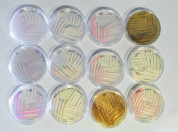Ecological research infrastructures in the Netherlands

From experimental mini-lakes to research vessels, and from living labs to collections. In The Netherlands we have many and diverse ecological research facilities. This website provides a national overview of the large-scale ecological research infrastructures.
For ecological researchers in the Netherlands this overview offers opportunities to team up with other researchers and to link to existing ecological research facilities and initiatives. Currently, the inventory of large-scale ecological research facilities focuses on ecotrons, scientific (data) collections, long-term field studies and research infrastructures for fieldwork.
Map
List
Filter by
Infrastructure type
Landscape type
Institute
Active filters
Filter by
Infrastructure type
Landscape type
Institute
Active filters
-
Aqua-flex Arena: Outdoor mesocosms
The Aqua-flex Arena is a fenced terrain (2500 m2; 80 x 32m) for performing outdoor mesoscosm experiments throughout the year, in the immediate promixity of the NIOO Aquatic Laboratories. Experiments can be performed with > 100 experimental units. There is great flexibility in the spatial set up of experimental units.
-
Aquaria
The Netherlands Institute of Ecology (NIOO-KNAW) houses 8 long glass aquaria (180 x 40 x 40 cm in length x width x height, 288L) and 24 shorter glass aquaria (90 × 50 × 50 cm in length x width x height, 225L). The aquaria can be kept at different temperatures which can be controlled by an automatic control system (Cascade Automation Systems, Ridderkerk, the Netherlands).
-
Aquatic Sensing Facility (Aquasense)
AquaSense is an outdoor aquatic facility (10 × 4 meters, depth 0.5–2 meters) designed for education and research in water quality monitoring using remote sensing techniques. It provides a controlled environment for measuring radiance, and other bio-physical properties of water, supporting hands-on learning and experimentation in hydro-optical modeling, sensor calibration, and aquatic system analysis.
-
ARISE
The ARISE project is building an infrastructure that will identify and monitor all multicellular species in the Netherlands.
-
Avian blood sample collection
Since 1994, we collect genetic samples from insects (winter moth) and birds (mainly great tit, blue tit, pied flycatcher, oystercatcher and various waterfowl). The location and specifications of a sample can be found in our relational data warehouse. There are more than 170,000 blood samples, feathers and other tissues stored at NIOO. The samples can be used to investigate the genotype of an individual or population in relation to their fenotype.
-
Bacterial collection
NIOO has a collection of thousands of bacterial strains isolated from different (semi-)natural and agricultural environments. Most are bacteria isolated from soils, rhizosphere or plant parts, but aquatic strains are present as well.
-
BioCliVE
The Utrecht University Biodiversity and Climate Variability Experiment, UU BioCliVE, is an experiment manipulating plant diversity and future precipitation scenarios to examine how biological diversity can provide us with natural insurance against climate change.
-
Bird Radar
The BirdScan radar is a radar to track aerial movement of animals. This information can be used to gain more insight in migration patterns and the influence of changes in the environment.
-
CBS-KNAW collections and databases
The CBS-KNAW culture collection from the Westerdijk Fungal Biodiversity Institute (WI-KNAW) is the largest in the world with more than 100.000 strains of fungi (including yeasts) and bacteria (including wild-type and mutant strains), hosts suitable for DNA research, genetically engineered plasmids, broad-host-range plasmids and phages.
-
CLUE field Veluwe + database
Since 1995, we run a series of biodiversity experiments on a former agricultural field in the nature area Planken-Wambuis near Ede. In some plots, secondary succession has followed its natural course, In other plots, a low or high diversity of plants was sown, or the soil has been inoculated with soil from nature areas.
-
Delta-ENIGMA
Delta-ENIGMA provides infrastructure for intensive field and experimental laboratory research to understand how organisms, currents, waves, water discharge and sediment transport jointly shape the Dutch delta-landscape. This integrated approach, known as biogeomorphology, lies at the core of Delta-ENIGMA. The program serves as the Dutch contribution to DANUBIUS-RI, a European research infrastructure for studying river-delta-coastal systems. The consortium members are Utrecht University, TU Delft, University of Twente, Wageningen University & Research, Royal Netherlands Institute for Sea Research (NIOZ), Deltares and TNO. Delta-ENIGMA is coordinated by the Department of Physical Geography at Utrecht University.
-
Eurasian oystercatcher research population Schiermonnikoog
The long-term study population of Eurasian oystercatchers on Schiermonnikoog is used to study (1) the causes of population change in this indicator species of the Wadden Sea ecosystem, (2) to understand how individuals and populations respond to rapid environmental change.
www.eco-ri.nl is initiated and maintained by the Netherlands Institute of Ecology (NIOO-KNAW), and supported by the Dutch universities and research institutes connected to NERN (Netherlands Ecological Research Network) and/or BiodiversityXL (Centre of Excellence for Netherlands Biodiversity Research).
The inventory of ecological research infrastructures is ongoing. You are very welcome to share additional information via our contact address below.
Highlighted Ecological Research Infrastructures
-
National Research Fleet
The National Research Fleet consists of three research vessels: RV Pelagia, RV Navicula and RV Adriaen Coenen.
-
Limnotrons
The limnotrons are twelve stainless steel indoor mesocosms or mini-lakes with a high level of control.
-
LTSER-platform Veluwe
The Veluwe is the largest connected nature area of the Netherlands, with a great array of ecological and socio-economic research.
Institutions with ecological research facilities
-
Delft University of Technology
-
Erasmus MC
-
HAS green academy
-
James Cook University Australia
-
Leiden University
-
Naturalis Biodiversity Center
-
Netherlands Institute of Ecology (NIOO-KNAW)
-
Radboud University
-
Rijkswaterstaat
-
Ringersvereniging (Bird banding society)
-
Royal Netherlands Institute for Sea Research (NIOZ)
-
Sovon
-
University of Amsterdam (UVA)
-
University of Groningen
-
University of Twente
-
Utrecht University
-
Wageningen University & Research
-
Westerdijk Institute
Contact
If you have any additions to the inventory, please contact the NIOO Research Support Office via rso@nioo.knaw.nl.





















